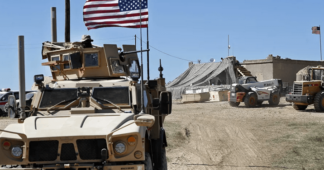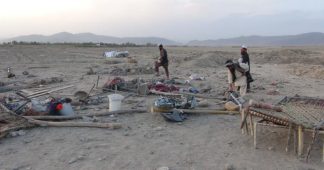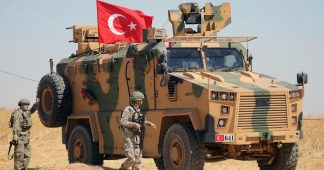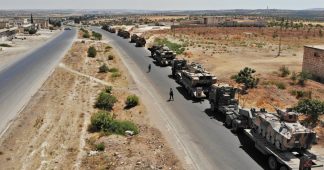A military report warned that striking the giant structure could cause tens of thousands of deaths
By Dave Philipps, Azmat Khan and Eric Schmitt
Near the height of the war against the Islamic State in Syria, a sudden riot of explosions rocked the country’s largest dam, a towering, 18-story structure on the Euphrates River that held back a 25-mile-long reservoir above a valley where hundreds of thousands of people lived.
The Tabqa Dam was a strategic linchpin and the Islamic State controlled it. The explosions on March 26, 2017, knocked dam workers to the ground and everything went dark. Witnesses say one bomb punched down five floors. A fire spread, and crucial equipment failed. The mighty flow of the Euphrates River suddenly had no way through, the reservoir began to rise, and local authorities used loudspeakers to warn people downstream to flee.
The Islamic State, the Syrian government and Russia blamed the United States, but the dam was on the U.S. military’s “no-strike list” of protected civilian sites and the commander of the U.S. offensive at the time, then-Lt. Gen. Stephen J. Townsend, said allegations of U.S. involvement were based on “crazy reporting.”
“The Tabqa Dam is not a coalition target,” he declared emphatically two days after the blasts.
In fact, members of a top secret U.S. Special Operations unit called Task Force 9 had struck the dam using some of the largest conventional bombs in the U.S. arsenal, including at least one BLU-109 bunker-buster bomb designed to destroy thick concrete structures, according to two former senior officials. And they had done it despite a military report warning not to bomb the dam, because the damage could cause a flood that might kill tens of thousands of civilians.
Given the dam’s protected status, the decision to strike it would normally have been made high up the chain of command. But the former officials said the task force used a procedural shortcut reserved for emergencies, allowing it to launch the attack without clearance.
Later, three workers who had rushed to the dam to prevent a disaster were killed in a different coalition airstrike, according to dam workers.
The two former officials, who spoke on the condition that they not be named because they were not authorized to discuss the strikes, said some officers overseeing the air war viewed the task force’s actions as reckless.
The revelation of Task Force 9’s role in the dam attack follows a pattern described by The New York Times: The unit routinely circumvented the rigorous airstrike approval process and hit Islamic State targets in Syria in a way that repeatedly put civilians at risk.
Even with careful planning, hitting a dam with such large bombs would likely have been seen by top leaders as unacceptably dangerous, said Scott F. Murray, a retired Air Force colonel, who planned airstrikes during air campaigns in Iraq, Afghanistan and Kosovo.
“Using a 2,000-pound bomb against a restricted target like a dam is extremely difficult and should have never been done on the fly,” he said. “Worst case, those munitions could have absolutely caused the dam to fail.”
After the strikes, dam workers stumbled on an ominous piece of good fortune: Five floors deep in the dam’s control tower, an American BLU-109 bunker-buster lay on its side, scorched but intact — a dud. If it had exploded, experts say, the whole dam might have failed.
In response to questions from The Times, U.S. Central Command, which oversaw the air war in Syria, acknowledged dropping three 2,000-pound bombs, but denied targeting the dam or sidestepping procedures. A spokesman said that the bombs hit only the towers attached to the dam, not the dam itself, and while top leaders had not been notified beforehand, limited strikes on the towers had been preapproved by the command.
“Analysis had confirmed that strikes on the towers attached to the dam were not considered likely to cause structural damage to the Tabqa Dam itself,” Capt. Bill Urban, the chief spokesman for the command, said in the statement. Noting that the dam did not collapse, he added, “That analysis has proved accurate.”
“The mission, and the strikes that enabled it, helped return control of the intact Tabqa Dam to the people of Northeast Syria and prevented ISIS from weaponizing it,” Captain Urban said. “Had they been allowed to do so, our assessments at the time predicted that they would have inflicted further suffering on the people of Syria.”
But the two former officials, who were directly involved in the air war at the time, and Syrian witnesses interviewed by The Times, said the situation was far more dire than the U.S. military publicly claimed.
Critical equipment lay in ruins and the dam stopped functioning entirely. The reservoir quickly rose 50 feet and nearly spilled over the dam, which engineers said would have been catastrophic. The situation grew so desperate that authorities at dams upstream in Turkey cut water flow into Syria to buy time, and sworn enemies in the yearslong conflict — the Islamic State, the Syrian government, Syrian Defense Forces and the United States — called a rare emergency cease-fire so civilian engineers could race to avert a disaster.
Engineers who worked at the dam, who did not want to be identified because they feared reprisal, said it was only through quick work, much of it made at gunpoint as opposing forces looked on, that the dam and the people living downstream of it were saved.
“The destruction would have been unimaginable,” a former director at the dam said. “The number of casualties would have exceeded the number of Syrians who have died throughout the war.”
A Ready-Made Fortress
The United States went into the war against the Islamic State in 2014 with targeting rules intended to protect civilians and spare critical infrastructure. Striking a dam, or other key civilian sites on the coalition’s “no-strike list,” required elaborate vetting and the approval of senior leaders.
But the Islamic State sought to exploit those rules, using civilian no-strike sites as weapons depots, command centers and fighting positions. That included the Tabqa Dam.
The task force’s solution to this problem too often was to set aside the rules intended to protect civilians, current and former military personnel said.
Soon, the task force was justifying the vast majority of its airstrikes using emergency self-defense procedures intended to save troops in life-threatening situations, even when no troops were in danger. That allowed it to quickly hit targets — including no-strike sites — that would have otherwise been off limits.
Rushed strikes on sites like schools, mosques and markets killed crowds of women and children, according to former service members, military documents obtained by The Times and reporting at sites of coalition airstrikes in Syria.
Perhaps no single incident shows the brazen use of self-defense rules and the potentially devastating costs more than the strike on the Tabqa Dam.
At the start of the war, the United States saw the dam as a key to victory. The Soviet-designed structure of earth and concrete stood 30 miles upstream from the Islamic State’s self-proclaimed capital, Raqqa, and whoever controlled the dam effectively controlled the city.
Rebel groups captured the dam in 2013, and the Islamic State took control during its violent expansion in 2014. For the next several years, the militants kept a small garrison in the dam’s towers, where the thick concrete walls and sweeping view created a ready-made fortress.
But it also remained a vital piece of civilian infrastructure. Workers at the dam continued to produce electricity for much of the region and regulate water for vast stretches of irrigated farmland.
In March 2017, when the United States and an international coalition launched an offensive to take the region from the Islamic State, they knew they would have to seize the dam to prevent the enemy from intentionally flooding allied forces downstream.
Task Force 9 was in charge of the ground offensive and had been devising ways to take the dam for months before the strike, according to one former official. The task force ordered a report from specialized engineers in the Defense Intelligence Agency’s Defense Resources and Infrastructure office to assess what size of bombs could safely be used in an attack.
The agency soon came back with a clear recommendation: Do not strike the dam.
In a presentation that ran about four pages, according to the two former officials, the engineers said small weapons like Hellfire missiles, which have 20-pound warheads, could be used on the earthen sections of the dam, but it was unsafe to use any bombs or missiles, no matter the size, on the concrete structures that controlled the flow of water.
The former officials said the report warned that a strike could cause a critical malfunction and a devastating flood that could kill tens of thousands of people. The findings echoed a United Nations report from January 2017, which stated that if attacks on the dam caused it to fail, communities for more than 100 miles downstream would be flooded.
The military report was completed several weeks before the strike and sent to the task force, one former official said. But in the final week of March 2017, a team of task force operators on the ground decided to strike the dam anyway, using some of the biggest conventional bombs available.
2,000-Pound Bombs
It is unclear what spurred the task force attack on March 26.
At the time, the U.S.-led coalition controlled the north shore of the reservoir and the Islamic State controlled the south. The two sides had been in a standoff for weeks.
Captain Urban said that U.S.-backed Syrian Democratic Forces tried to take control of the dam and came under fire from enemy fighters, taking “heavy casualties.” Then the coalition struck the dam.
Dam workers said they saw no heavy fighting or casualties that day before the bombs hit.
What is clear is that Task Force 9 operators called in a self-defense strike, which meant they did not have to seek permission from the chain of command.
A military report obtained through a Freedom of Information Act lawsuit shows the operators contacted a B-52 bomber circling high overhead and requested an immediate airstrike on three targets. But the report makes no mention of enemy forces firing or heavy casualties. Instead, it says the operators requested the strikes for “terrain denial.”
The two former officials said the terrain denial request suggested that allied forces were not in danger of being overrun by enemy fighters, and that the task force’s goal was likely to preemptively destroy fighting positions in the towers.
Launching that type of offensive strike under self-defense rules was a stunning departure from how the air war was supposed to work, the officials said.
Just a few weeks later, when the United States decided to disable a canal system near Raqqa, the strikes had to be approved by a military targeting board in what one former official called “an exhaustively detailed” process.
None of that happened with the dam, he said.
A senior Defense Department official disputed that the task force overstepped its authority by striking without informing top leaders. The official said the strikes were conducted “within approved guidance” set by the commander of the campaign against the Islamic State, General Townsend. Because of that, the official said, there was “no requirement that the commander be informed beforehand.”
First, the B-52 dropped bombs set to explode in the air above the targets to avoid damaging the structures, the senior military official said. But when those failed to dislodge the enemy fighters, the task force called for the bomber to drop three 2,000-pound bombs, including at least one bunker-buster, this time set to explode when they hit the concrete.
The task force also hit the towers with heavy artillery.
Days later, Islamic State fighters fled, sabotaging the dam’s already inoperable turbines as they retreated, according to engineers.
Satellite imagery from after the attack shows gaping holes in the roofs of both towers, a crater in the concrete of the dam next to the head-gates, and a fire in one of the power station buildings. Less obvious, but more serious, was the damage inside.
An Unusual Truce
Two workers were at the dam that day. One of them, an electrical engineer, recalled Islamic State fighters positioned in the northern tower as usual that day, but no fighting underway when they went into the dam to work on the cooling system.
Hours later, a shuddering series of booms knocked them to the floor. The room filled with smoke. The engineer found his way out into the sunlight through a normally locked door that had been blown open.
He froze when he saw the broad wings of an American B-52 against the clear blue sky.
Fearing that he would be mistaken for an enemy fighter, the engineer ducked back into the smoldering tower. The strikes had punched a jagged skylight through several stories. He looked up and saw fire coming from the main control room, which had been hit by the airstrike.
The dominoes of a potential disaster were now in motion. Damage to the control room caused water pumps to seize. Flooding then short-circuited electrical equipment. With no power to run crucial machinery, water couldn’t pass through the dam, the reservoir crept higher. There was a crane that could raise the emergency floodgate, but it, too, had been damaged by fighting.
But the engineer knew if they could find a way to get the crane working, they might be able to open the floodgates.
He hid inside until he saw the B-52 fly away and then found a motorcycle. Though he had never driven one before, he sped as fast as he could to the house where the dam manager lived, and explained what had happened.
Engineers in Islamic State territory called their former colleagues in the Syrian government, who then contacted allies in the Russian military for help.
A few hours after the strike, a special desk phone reserved for directed communications between the United States and Russia started ringing in a busy operations center in Qatar. When a coalition officer picked up, a Russian officer on the other end warned U.S. airstrikes had caused serious damage to the dam and there was no time to waste, according to a coalition official.
Less than 24 hours after the strikes, American-backed forces, Russian and Syrian officials and the Islamic State coordinated a pause in hostilities. A team of 16 workers — some from the Islamic State, some from the Syrian government, some from American allies — drove to the site, according to the engineer, who was with the group.
They worked furiously as the water rose. The distrust and tension were so thick that at points fighters shot into the air. They succeeded in repairing the crane, which eventually allowed the floodgates to open, saving the dam.
Another Strike
The U.S.-backed Syrian Democratic Forces dismissed reports of serious damage as propaganda. A spokeswoman said the coalition had struck the dam with only “light weapons, so as not to cause damage.”
A short time later, General Townsend denied the dam was a target and said, “When strikes occur on military targets, at or near the dam, we use noncratering munitions to avoid unnecessary damage to the facility.”
But in the days after the strike, officers working for the coalition air war saw Islamic State images of the unexploded bunker buster and tried to figure out what had really happened, one official said. Every U.S. airstrike is supposed to be immediately reported to the operations center, but Task Force 9 had not reported the dam strikes. That made them hard to trace, said one former official who searched for the records. He said a team was only able to piece together what the task force had done by reviewing logs from the B-52.
At the air operations center, senior officials were shocked to learn how the top secret operators had bypassed safeguards and used heavy weapons, according to one of the former officials, who reviewed the operation.
No disciplinary action was taken against the task force, the officials said. The secret unit continued to strike targets using the same types of self-defense justifications it had used on the dam.
While the dam was still being repaired, the task force sent a drone over the community next to the dam. As the drone circled, three of the civilian workers who had rushed to save the dam finished their work and piled into a small van and headed back toward their homes.
More than a mile away from the dam, the van was hit by a coalition airstrike, according to workers. A mechanical engineer, a technician and a Syrian Red Crescent worker were killed. The deaths were reported widely in Syrian media sources online, but because the reports got the location of the attack wrong, the U.S. military searched for strikes near the dam and determined the allegation was “noncredible.” The civilian deaths have never been officially acknowledged.
The United States continued to strike targets and its allies soon took control of the region.
Published at archive.fo
We remind our readers that publication of articles on our site does not mean that we agree with what is written. Our policy is to publish anything which we consider of interest, so as to assist our readers in forming their opinions. Sometimes we even publish articles with which we totally disagree, since we believe it is important for our readers to be informed on as wide a spectrum of views as possible.










